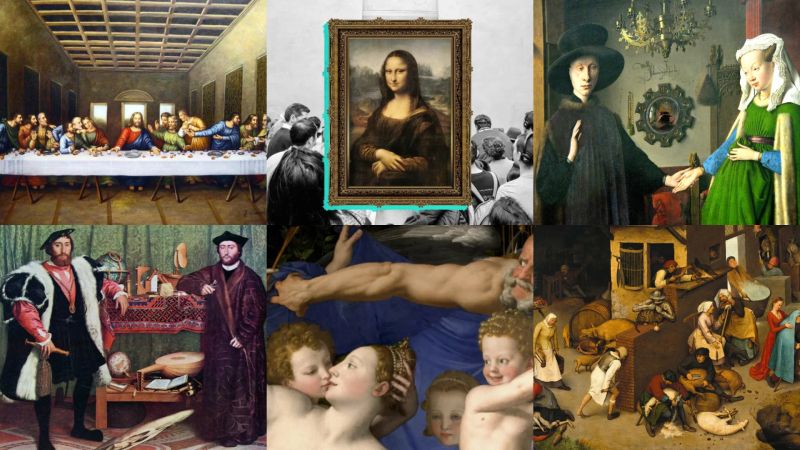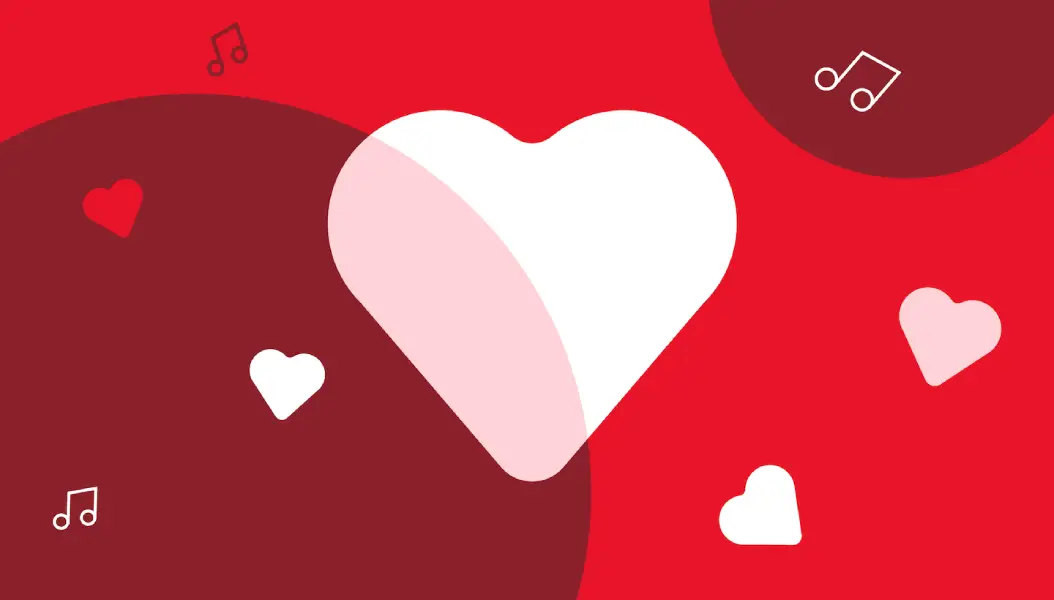Did you know that some of the world’s most famous paintings have hidden messages right in front of us? You heard it right! Historical artists used to include secret symbols, mysterious messages, and clues to convey deeper meanings. One example is the Renaissance Era, where artists used their artworks to share stories and hidden meanings. Renaissance art is full of surprises, including hidden codes, mysterious messages, and secret symbols. These hidden messages delve deeper into the information about science, religion, politics, philosophy, and human nature.
The Renaissance era gave some of the most beautiful and popular artwork that hides secret messages, codes, and symbols. Those secret messages sometimes revealed hidden facts and resemblances and sometimes even sparked conspiracy theories. Numerous mysterious messages hidden in Renaissance artwork have been revealed via careful and meticulous analysis. From Da Vinci’s cryptic codes to Michelangelo’s anatomical secrets, in this blog, we are going to share 10 Mysterious Messages Hidden in Renaissance Artwork.
Leonardo da Vinci’s “The Last Supper”
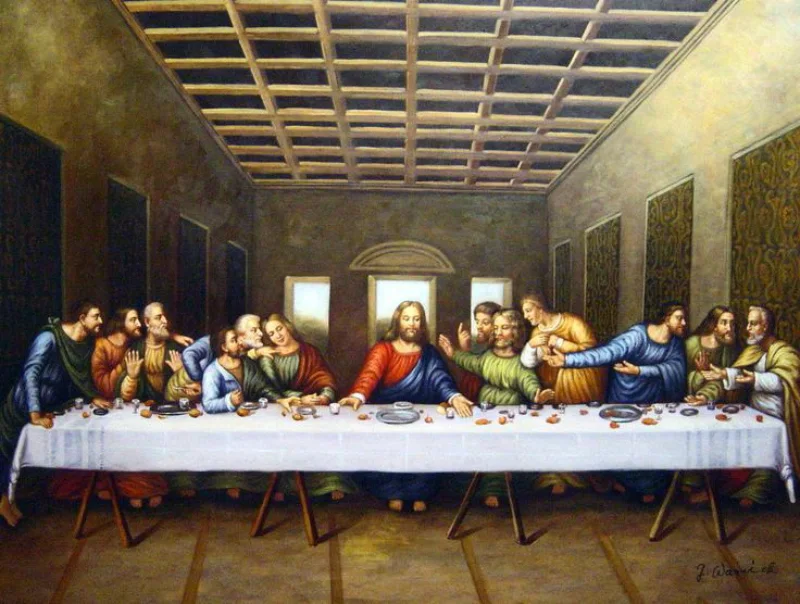
The Last Supper is one of Leonardo da Vinci’s most famous and mysterious artworks from the Renaissance period. Recently, Google created its high-resolution scan at 1 billion pixels and made it available online. According to the researchers, there is a split salt next to Judas’s right arm, which is regarded as a bad omen in Christian symbolism. Along with that, Peter is clutching a knife, which means he is planning to halt Jesus’s arrest by cutting off a soldier’s ear.
The second mysterious message in that artwork is the arrangement of hands and loaves of bread in The Last Supper. Researchers suggested that it represents musical notes when read from right to left.
Another popular conspiracy in that painting is the figure of Mary sitting on Jesus’s right side. Many people misunderstand that person as disciple John, but in reality, it is Mary Magdalene who was Jesus’s disciple as well as his wife. This hidden message reveals their relationship. Also, there is a “V” shape between them, symbolizing a woman’s womb, suggesting they had a baby together.
Hans Holbein the Younger’s “The Ambassadors”
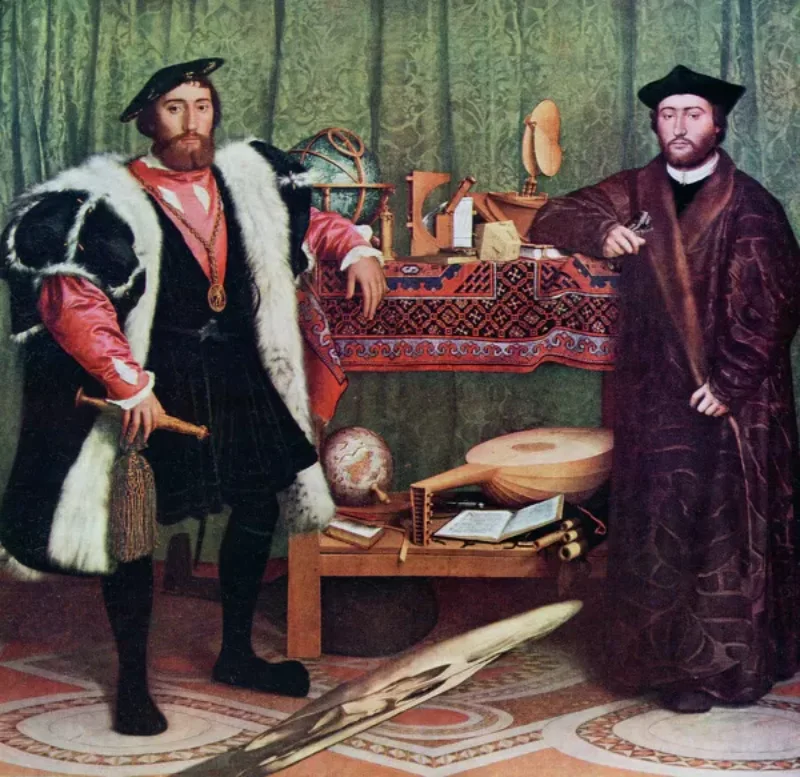
Hans Holbein the Younger’s The Ambassadors is a masterpiece that contains a range of symbolic elements and hidden messages. The painting depicts two men, Jean de Dinteville (a French ambassador) and Georges de Selve (a bishop), standing in a lavish interior, surrounded by various objects.
One of the most famous features of The Ambassadors is the distorted skull at the bottom of the painting. It is believed that the skull becomes clearly visible only when seen from the right angle. This is actually called Anamorphosis, a visual trickery art form in which the artist creates an image that looks distorted or unclear at first. But when you look at it from the right angle, the image comes together and makes sense.
Art historians call it a Memento Mori, meaning “remember you must die.” It reminds us of the transient nature of life and the inevitability of death.
Jan van Eyck’s “The Arnolfini Portrait”
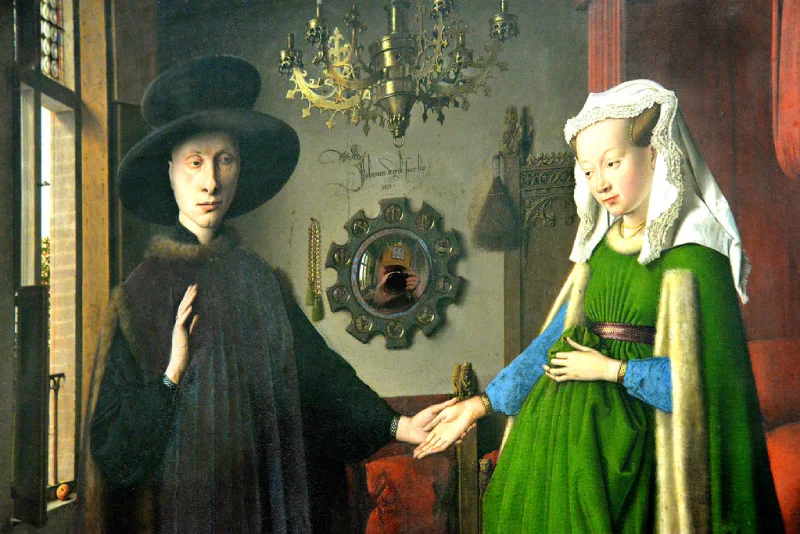
Jan van Eyck’s The Arnolfini Portrait is one of the most iconic works of Northern Renaissance art. It is a richly detailed painting with many hidden messages embedded in its symbolism. The writing on the wall reads, “Jan van Eyck was here 1434,” which depicts the artist tagging his own painting to the wall.
Along with that, in the mirror, there is a detailed reflection of the scene. With a magnifying glass, you can even spot two other people entering the room. One of those people with the raised hand is believed to be the artist Van Eyck himself. Some people believe that Van Eyck wrote his name as a witness to the marriage of the couple in the painting, Giovanni di Nicolao Arnolfini and his wife. This idea suggests the painting was not just an artwork but a formal record of their marriage, which is an interesting theory.
There are other symbols also that have different meanings. The one-lit candle on the chandelier symbolizes God’s presence and blessing on the union. The dog stands for loyalty, the green dress symbolizes youth and fertility, and the objects around show the couple’s wealth and social status.
Da Vinci’s “Mona Lisa”
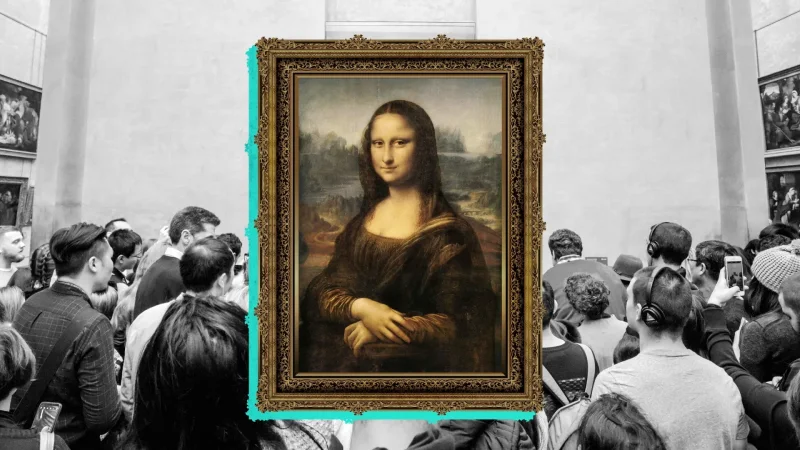
The Mona Lisa is one of the most famous artworks of Da Vinci that has been captivating scholars and researchers for years. Using magnification, researchers and symbolists claimed that there are tiny letters and numbers in Mona Lisa’s eyes. There is an “LV” in the right eye, which depicts Leonardo Davinci. It is believed that this was Vinci’s way of showing the world that the artwork’s rights belong to him. Apart from that, “C” and “E” or “B” and “S” are also present in the left eye. By adding the letters “LVCE,” there is a hidden number “2,” which is believed to have a secret message or model’s identity.
Additionally, the number “72” or “L2” can be seen under the bridge, which some interpret as a symbol of creation and duality. The “7” represents the world’s creation, while the “2” may symbolize the duality of men and women.
Another mysterious message hidden in this Renaissance artwork is an image of other women. A French scientist, Pascal Cotte, claimed he had found a woman different from the Mona Lisa, looking to the side instead of at the artist.
Michelangelo’s “The Creation of Adam”
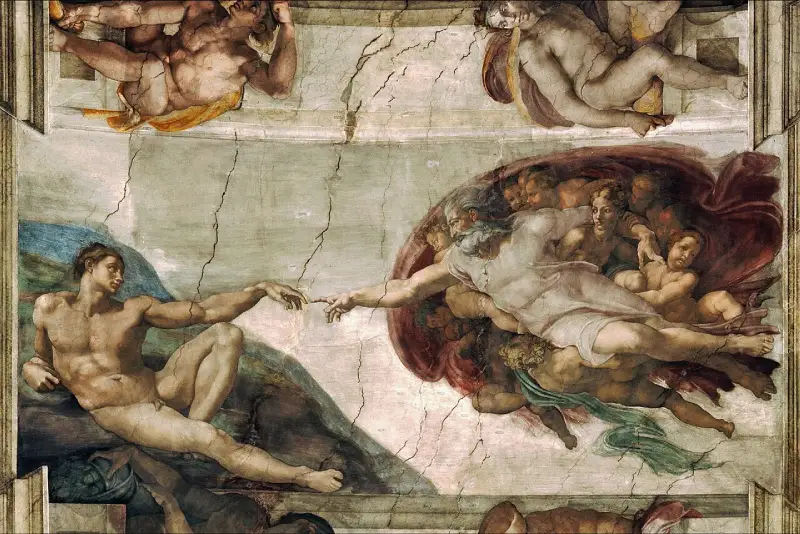
Michelangelo’s The Creation of Adam is one of the most famous artworks on the ceiling of the Sistine Chapel. The most mysterious message in this Renaissance artwork is God giving life to Adam by touching his finger. According to art experts, this symbolizes the transfer of life from the divine to the human. Adam’s posture is relaxed and almost passive, lying on the ground with his body arched. Art researchers say this passivity shows that humans rely on God for life and creation.
The reddish-brown structure surrounding God in the painting and the angels on the right resemble a human brain. Researchers have also claimed that all of the 9 panels resemble body part outlines, like the vertebral artery, cerebellum, pituitary gland, etc. Michelangelo, who had studied human bodies by dissecting them, designed the shape to look like a big brain.
Some believe Michelangelo painted the brain to depict God granting Adam knowledge and intelligence. Others believe it was a hidden protest against the church’s decision of rejection of science.
Caravaggio’s “Supper at Emmaus”
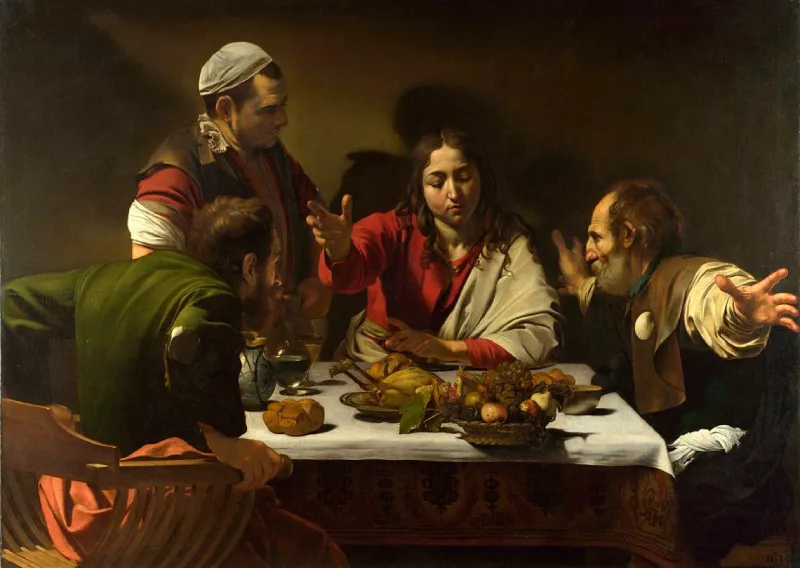
Caravaggio’s Supper at Emmaus is a masterpiece that looks very simple in the first glimpse. A group of men eating around a small dining table in a dark room. The men around the main figure look emotional, but the central figure—likely Jesus Christ, clean-shaven—stays calm and steady, gesturing wisely with his right hand. There’s a bowl of fruit on the table, but Jesus is usually associated with fish and bread. Also, if you look closely, you will see a shadow on the table, something like a fishtail. Researchers believe this painting shows the resurrected Jesus meeting his disciples before vanishing. Caravaggio included several hints in this Renaissance masterpiece, like the fishtail shadow.
Moreover, Christ is shown without a beard, which represents renewal, resurrection, and hope amid the disciples’ chaos. The disciples’ gestures are dramatic, conveying shock and understanding of how humans struggle to understand divine mysteries. The items on the table, including bread, wine, and fruit, represent themes of sacrifice and redemption.
Pieter Bruegel the Elder’s “Netherlandish Proverbs”
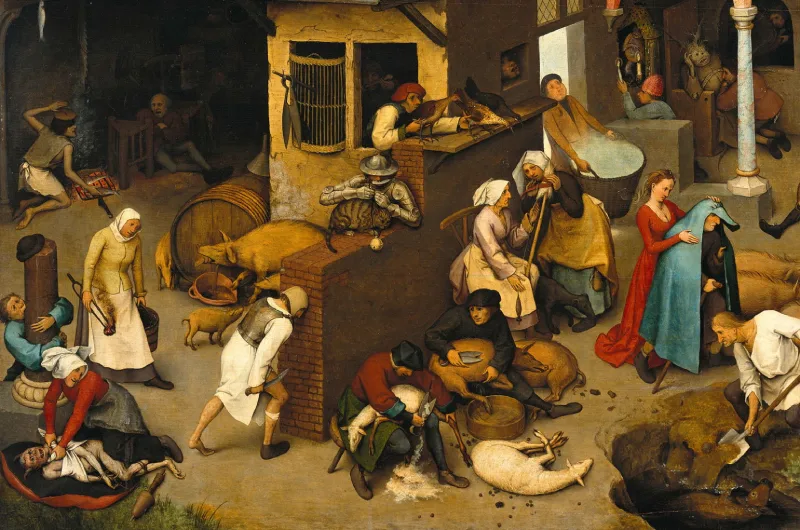
Pieter Bruegel, the Elder’s Netherlandish Proverbs, is a fascinating artwork that is a treasure trove of hidden messages. It’s a game of “Where’s Waldo” that has over 100 visual representations of Dutch proverbs, idioms, and moral lessons. By looking closely, you can understand each scene and character in the painting actually represents a proverb. Some popular proverbs including “Don’t cry over spilled milk” and “The world is turned upside down,” etc., remain familiar today.
Other proverbs include “Killing two flies with one stroke,” “Birds of a feather flock together,” “Swimming against the tide,” etc. Proverbs are often depicted through scenes or characters, like “Big fish eat little fish,” which is shown by a man holding a large fish with smaller ones spilling out, symbolizing exploitation.
In total, there are 112 hidden proverbs in Netherlandish Proverbs. Some of them are forgotten in the present times; some have been modified, while some still hold strong usage.
Caravaggio’s “Bacchus”
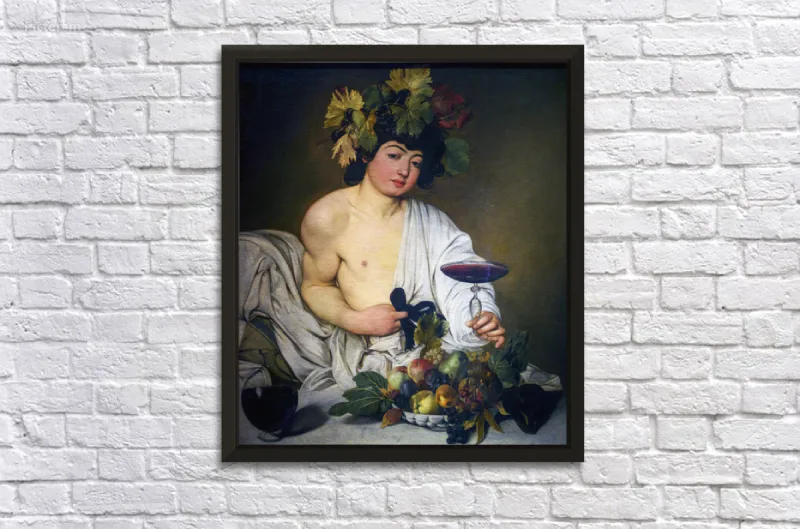
Caravaggio’s Bacchus is an intriguing painting that portrays the Roman god of wine in an unusual and unconventional way. It features a large glass of wine, a bowl of fruit, a relaxed Dionysus in a toga, and a tiny artist drowning in a carafe. Art restoration specialists claim that it is Caravaggio around the age of 25. The painting presents him as a youthful, almost effeminate young man. This was first noticed by a restorer cleaning the painting in 1922, but due to poor restoration efforts in the following years, “it became undetectable.”
In 2009, researchers used a technique called reflectography to uncover Caravaggio’s tiny self-portrait. On the bottom left of the artwork, there is an image of a man sitting upright. Instead of being inside the carafe of wine, he seems to be reflecting on it, with his arm reaching out toward a canvas to paint.
Caravaggio was known to drink heavily and have extreme mood swings. Some art experts believe he painted himself trapped in a wine bottle to represent his struggle with alcohol.
Hieronymus Bosch’s “The Garden of Earthly Delights”
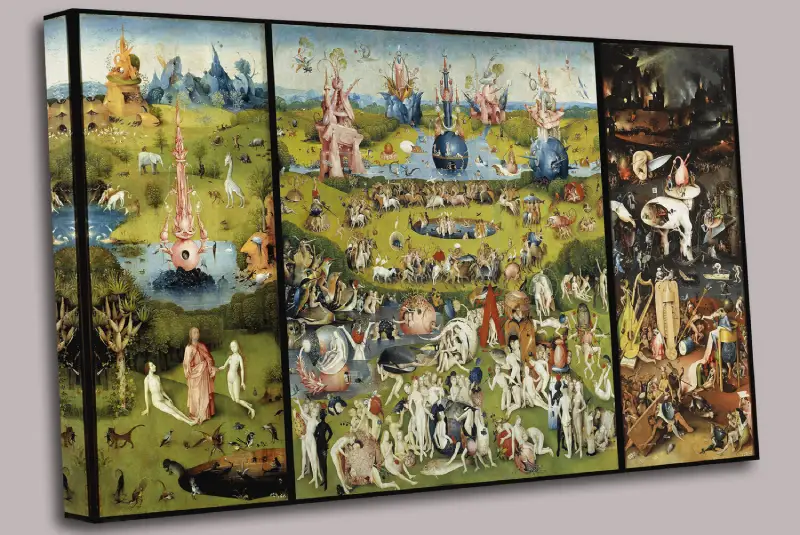
Hieronymus Bosch’s The Garden of Earthly Delights is one of the most enigmatic paintings in Western art. This is another painting that shows “Where’s Waldo” with a number of hidden and mysterious messages. These hidden messages explore the themes of human nature, sin, temptation, and salvation. This masterpiece was crafted meticulously. It took Artist Hieronymus Bosch literally 20 years to finish this masterpiece. In 2014, a student discovered hidden musical notes in the artwork. In the lower left-hand corner, there is a musical score tattooed on one tortured inhabitant’s butt. When you play the music, it’s actually very creepy. It sounds like a caution against the unending hazards of sin.
Then, there is a triptych format, with three panels representing the stages of life. The left shows Eden, symbolizing innocence; the center portrays indulgence and earthly pleasures; and the right depicts Hell, showing the consequences of sin. The central panel contains numerous naked figures representing indulgence in physical pleasure, vanity, and temptation.
There are some animals also, like owls, that represent wisdom and knowledge, a unicorn that symbolizes the perversion of purity, and many more.
Angolo Bronzino’s “An Allegory with Venus and Cupid”
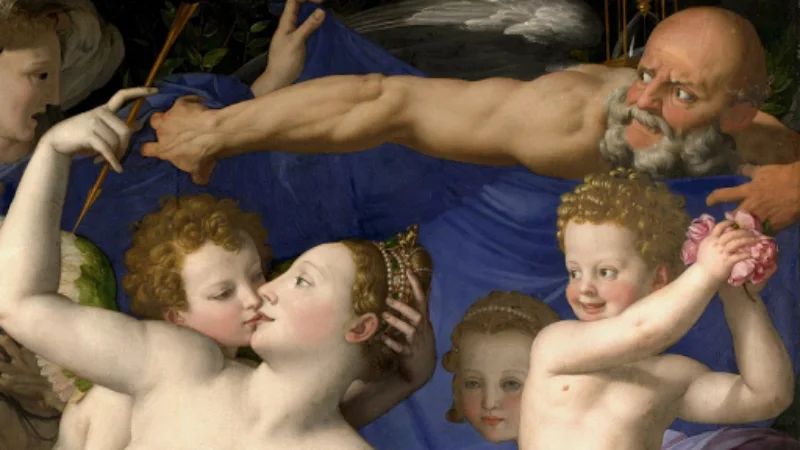
Angolo Bronzino’s An Allegory with Venus and Cupid is a highly intricate painting filled with mysterious symbols and messages. It features symbolic imagery that reflects themes of love, lust, deception, and the temporary nature of beauty. It is believed that the main message of the artwork is that unchaste love brings both joy and painful consequences. The central figures of Venus and Cupid represent the theme of love and lust. While Venus is shown in a sensual pose, Cupid is depicted in an unusual manner, which signifies both affection and passion. Then, there is a small child’s foot next to Venus. As per the researchers, the child’s careless reaction may symbolize nerve damage or syphilis.
There are two figures in the background. One is a woman emerging from a cloud, appearing almost angelic, while the other is a man with more devilish expressions. The woman is believed to signify pure (Truth), while the man signifies lies and deception.
Above everything else, there is one hidden and spooky element: “The little girl is a monster in disguise.”
Conclusion
In conclusion, Renaissance art is full of fascinating, mysterious messages and symbols that go beyond what we see at first glance. Artists like Leonardo da Vinci, Michelangelo, Hieronymus Bosch, and Caravaggio used their artwork to express deeper meanings about life, science, religion, and human nature. Whether it’s secret codes, mysterious figures, or symbolic details, these artworks still hold many secrets that continue to surprise us today. We have discussed some of the most intriguing artworks and the hidden messages and elements present in them. From the presence of Mary in The Last Supper to the little girl as a monster in An Allegory with Venus and Cupid, we have covered it all. So, next time you see a painting, remember there might be hidden meanings waiting to be unveiled!
